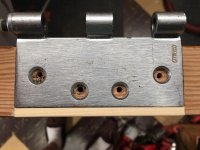I agree that a sharp set of chisels is a great way to knock out squared-off hinge mortises, but you'll need to break out a router for hinges with 1/4" and 5/8" radius corners. Most of my work is remodel, so I'm frequently subject to existing hinge configurations, and most older homes I work on have 5/8" radius hinges.
The Templaco guides are great, one template will handle the door, as well as the jamb. For bigger jobs, I'll measure existing hinge spacing and order a custom template to match the existing layout.
The Templaco templates are based on the assumption that you're using a 1/2" bit and 5/8" bushing. I have a OF1010 set aside specifically for mortising work, makes hinge mortising a breeze.
The advantage of the Templaco is that, rather than being clamped, it is nailed to the edge of the door, thus allowing for accommodating a beveled door edge, frequently needed if you're allowing for a tweaked, existing jamb where a square edge would leave you hinge-bound. The two nail holes are easily filled.
For larger jobs with non-standard door heights or hinge layouts I'll order a custom template from Templaco, far cheaper than doing it by hand or making my own template.
https://www.templaco.com/html/dspFullLengthTemplates.asp?ManufacturerChoice=Templaco




